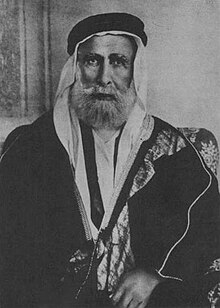Kingdom of Hejaz
Kingdom of Hejaz مملكة الحجاز Mamlakat al-Ḥijāz | |||||||||||
|---|---|---|---|---|---|---|---|---|---|---|---|
| 1916–1925 | |||||||||||
 Kingdom of Hejaz (green) and present Hejaz region (red) on the Arabian Peninsula. | |||||||||||
| Capital | Mecca | ||||||||||
| Common languages | Arabic Ottoman Turkish | ||||||||||
| Religion | Sunni Islam | ||||||||||
| Government | Absolute monarchy | ||||||||||
| King | |||||||||||
• 1916–1924 | Hussein bin Ali | ||||||||||
• 1924–1925 | Ali bin Hussein | ||||||||||
| Historical era | Interwar period | ||||||||||
• Kingdom established | 10 June 1916 | ||||||||||
| 10 August 1920 | |||||||||||
| 19 December 1925 | |||||||||||
• Ibn Saud crowned King of Hejaz | 8 January 1926 | ||||||||||
| Population | |||||||||||
• 1920 | 850,000 | ||||||||||
| |||||||||||
The Kingdom of Hejaz (Template:Lang-ar, Mamlakat al-Ḥijāz) was a state in the Hejaz region ruled by the Hashemite family. It became independent from the collapsing Ottoman Empire as a result of World War I when the Sharif of Mecca made a deal with the British that the Arab population would be instigated to revolt against the Turks in exchange for a unified Arab country. The Hejaz region had strategic infrastructure, particularly the Hejaz Railway, which was being used to reinforce Turkish forces in the region.
The kingdom was conquered in 1925 by the neighbouring Sultanate of Nejd under a resurgent House of Saud, creating the Kingdom of Hejaz and Nejd.[1] On 23 September 1932, the Kingdom of Hejaz and Nejd joined the Saudi dominions of Al-Hasa and Qatif as the unified Kingdom of Saudi Arabia.[2][3]
History

In 1916, the Sharif of Mecca Hussein bin Ali declared himself King of Hejaz as his Sharifian Army participated with other Arab forces and the British Empire in expelling the Turks from the Arabian peninsula.[4][5]
Kings of Hejaz
- Hussein bin Ali (10 June 1916 – 3 October 1924)
- Ali bin Hussein (3 October 1924 – 19 December 1925)
See also
References
- ^ Yamani, Mai (2009), Cradle of Islam : the Hijaz and the quest for an Arabian identity (Pbk. ed.), I.B. Tauris, ISBN 978-1-84511-824-2
- ^ Madawi Al-Rasheed. A History of Saudi Arabia. Cambridge, England, UK: Cambridge University Press, 2002.
- ^ A Brief overview of Hejaz - Hejaz history
- ^ Baker, Randall (1979), King Husain and the Kingdom of Hejaz, Oleander Press, ISBN 978-0-900891-48-9
- ^ Teitelbaum, Joshua (2001), The rise and fall of the Hashimite Kingdom of Arabia, New York University Press, ISBN 978-0-8147-8271-2


